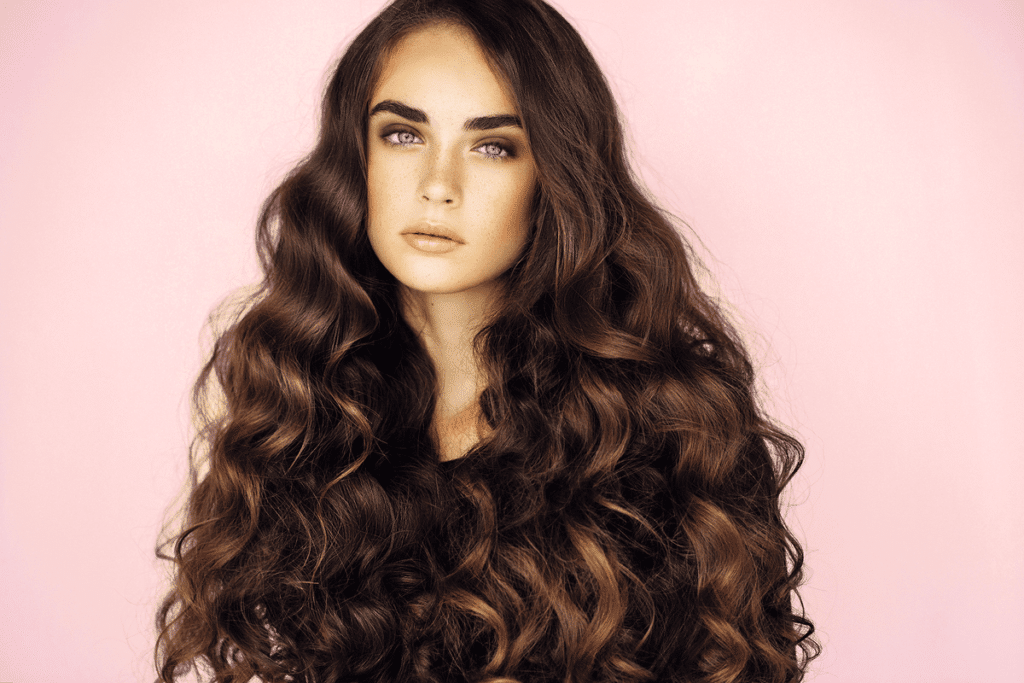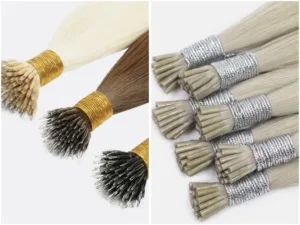Diving into the world of hair extensions can feel like decoding a complex puzzle. How many pieces do you need? Whether you’re a newbie or a seasoned pro, understanding the nuances of extension types, hair thickness, desired volume, and professional insights is crucial.
The quantity of hair extensions you need hinges on the method of application and your desired outcome. For a full head:
Clip-ins: 5-7 pieces.
Tape-ins: 40-60 tapes.
Fusion/Bonded Extensions: 100-150 strands.
Micro-links/Micro-beads: 100-200 strands.
Wefts (Hair Weave): 1-3 bundles or packs.
However, individual hair thickness, desired volume, and style will dictate the final count.
Dive deeper to discover the intricacies of choosing the right extensions. From understanding the types, assessing your hair thickness, to gauging the style, we have detailed insights to guide your choices. Together, let’s unlock the secrets to a flawless, voluminous mane.

Understanding Extensions types
Navigating the world of extensions can feel like you’ve been thrown into a labyrinth. Let’s illuminate the path and journey through together:
Clip-ins: These are the equivalent of a fashionista’s accessory—easy to pop on for a out and equally easy to remove before bed. Clip-ins are wefts of hair attached to small clips. These clips snap onto your natural hair, offering both volume and length. Typically, for a luscious, full look, you’d aim for around 5-7 pieces, spread across your head. Bonus? No commitment needed.
Tape-ins: . These are thin hair sections attached to clear, double-sided adhesive tapes. The tapes are pressed together with a section of your natural hair in between. Ideal for those seeking a longer-lasting solution without the permanence, tape-ins can last 4-8 weeks with proper care. For a head-turning, voluminous appearance, 40-60 tapes should do the trick.
Fusion/Bonded Extensions: Using either hot or cold fusion methods, individual strands are bonded to your natural hair using adhesives like keratin. These extensions require a significant time investment initially but can last for months. They provide a seamless, blended look and are perfect for those after a more permanent solution. For that runway-ready volume, you’re looking at between 100-150 strands.
Micro-links/Micro-beads: The casual, comfy jeans of the extension world—flexible and adaptable. Here, extensions are attached using tiny metal beads or cylinders. Your natural hair is threaded through the bead along with the extension, and then the bead is clamped shut. It’s a no-glue, no-heat method, which can be appealing to many. For a transformative, full-head look, 100-200 strands should be your aim.
Wefts (Hair Weave): A more traditional method, wefts involve horizontal rows of hair, which are braided into your natural hair and then sewn in place. It’s a robust method often preferred by those with thicker hair. Depending on your desired outcome—whether it’s dramatic Rihanna-level volume or a subtle, A-list oomph—you’ll need 1-3 bundles(100g/bundle) or packs(100g/pack). If the single piece weight is relatively small, such as handtied hair wefts, 6-12 pieces are recommended.
Each method offers unique benefits, so it’s essential to consider not only the desired look but also the lifestyle and commitment you’re willing to make. Remember, darling, your hair, your rules!

Your Existing Hair Thickness
Just as a tailor considers body size when crafting a garment, understanding your hair’s natural thickness is paramount when selecting extensions. Here’s how your hair type can influence your extension choices:
Thick Hair
Fortunate to have a lion’s mane? Here’s how it plays out across different extension types:
Clip-ins: Because of the natural volume, 3-5 pieces might suffice.
Tape-ins: 30-50 tapes should blend well without being overbearing.
Fusion/Bonded Extensions: 80-130 strands will likely offer the volume and blend you desire.
Micro-links/Micro-beads: Considering the natural density, 80-180 strands are often enough.
Wefts (Hair Weave): 1-1.5 bundles(100g/bundle) should seamlessly integrate with your thick hair. If the single piece weight is relatively small, such as handtied hair wefts, 6-8 pieces are recommended.
Medium Hair
The middle ground offers great flexibility. Here’s a guide based on this hair type:
Clip-ins: 5-7 pieces will generally give a balanced look.
Tape-ins: 40-60 tapes are the sweet spot for most.
Fusion/Bonded Extensions: Aiming for 100-140 strands should suffice.
Micro-links/Micro-beads: Typically, 100-190 strands give the best results.
Wefts (Hair Weave): 2 bundles(100g/bundle) are often just right. If the single piece weight is relatively small, such as handtied hair wefts, 8-10 pieces are recommended.
Fine Hair
Starting with a softer base, here’s what you might consider:
Clip-ins: To achieve volume and coverage, 6-8 pieces can be ideal.
Tape-ins: Because they’re lightweight, you might need 50-70 tapes for a fuller appearance.
Fusion/Bonded Extensions: Given the delicate nature of fine hair, 110-150 strands can be perfect.
Micro-links/Micro-beads: 120-200 strands might be required to get that voluminous look.
Wefts (Hair Weave): 2-3 bundles(100g/bundle) can create the desired thickness and volume. If the single piece weight is relatively small, such as handtied hair wefts, 10-12 pieces are recommended.
But remember, these numbers are just a starting point. Hair extension is as much an art as it is a science. Every individual has unique hair characteristics, so it’s essential to consider these general guidelines but adjust based on personal needs and professional advice. The ultimate goal? A beautiful, blended finish that amplifies your natural beauty!

Desired Volume & Style
Selecting the ideal hair extensions is not just about the thickness of your natural hair but also about the aesthetic you’re aiming for. Here’s a deep dive:
Going for the Glam
Channel that show-stopper look! Depending on your base hair type:
Clip-ins: Opt for 7-10 pieces to achieve that diva density.
Tape-ins: Around 60-70 tapes will deliver that captivating cascade.
Fusion/Bonded Extensions: Go up to 130-180 strands for that unmistakable bounce.
Micro-links/Micro-beads: Roughly 180-220 strands for an unmistakably bold aura.
Wefts (Hair Weave): 2-3 bundles will get you that star-studded appearance. If the single piece weight is relatively small, such as handtied hair wefts, 10-12 pieces are recommended.
Subtle Sophistication
For a touch of refinement:
Clip-ins: 4-6 pieces can subtly enhance your hair, especially if you’re just aiming for volume.
Tape-ins: 30-50 tapes should suffice.
Fusion/Bonded Extensions: 80-120 strands will seamlessly blend, adding gentle volume or length.
Micro-links/Micro-beads: Around 90-160 strands should do.
Wefts (Hair Weave): 1-2 bundles for that soft and natural look. If the single piece weight is relatively small, such as handtied hair wefts, 8-10 pieces are recommended.
Texture Matters
Curly Hair: Because of its volume, you might need fewer extensions. For example, with tape-ins, 30-50 might suffice.
Straight Hair: Here, the hair lies flat, so you might need a bit more. Tape-ins might require around 50-70 pieces.
Wavy Hair: It’s a balance. For tape-ins, typically 40-60 pieces are perfect.
Remember, these are guidelines. Consultation with a stylist, combined with your desired look and natural hair type, will offer the most accurate advice on the number of extensions you’ll need.

Consult Your Hairstylist
Alright, buddy, before we even delve deeper into this, let’s get one thing straight: your hairstylist? They’re your hair’s bestie. Your fairy godmother (or godfather) of tresses. And here’s why consulting them before taking the hair extension leap is oh-so-crucial:
An Eye for Detail: While you might know your hair well, hairstylists have this uncanny ability to see things you might miss. They’ll consider your face shape, your hair’s texture, density, and natural color, ensuring the extensions blend seamlessly and look, dare I say, “naturally” fabulous.
Customized Recommendations: Sure, you might want that Ariana Grande ponytail, but is it the best style for you? Your stylist can suggest modifications or entirely different styles that will complement your look even better. They might even introduce you to extension options you hadn’t considered.
Application Expertise: If you’re considering permanent or semi-permanent extensions, the application process is key. A skilled hairstylist will ensure that the extensions are attached securely without damaging your natural hair. They’ve got tricks up their sleeves to make sure there’s minimal tugging, pulling, or stress on your roots.
Maintenance Tips and Tricks: Extensions are an investment. Your stylist can guide you on the best practices to care for them, from the right products to use to techniques in brushing and styling. They’ll steer you clear from those dreaded extension faux pas that can cut short your extension’s lifespan.
Safety First: A good hairstylist will also ensure that the extension process is safe. This means checking for allergies (some people react to certain adhesives), ensuring there’s no excessive tension on the scalp, and advising on when to give your hair a break.
Planning Ahead: Thinking about coloring your hair or trying a chemical treatment? Your stylist can guide you on the do’s and don’ts when extensions are part of the equation. They’ll chart out a roadmap for your hair adventures, ensuring each step enhances the other.
So, before diving into the extension pool, have a sit-down with your stylist. Think of it as a hair heart-to-heart. With their expertise, your extension journey is bound to be smoother, more effective, and tailored just for you!

Conclusion
Hair extensions are more than just added strands; they’re an expression of your style, a boost of confidence, and an enhancement of natural beauty. By understanding your needs, consulting professionals, and prioritizing quality, you can achieve a seamless blend and look that’s uniquely yours. Here’s to hair that makes a statement!




